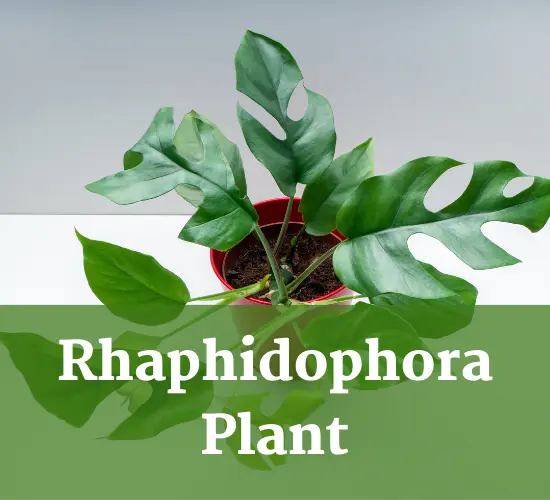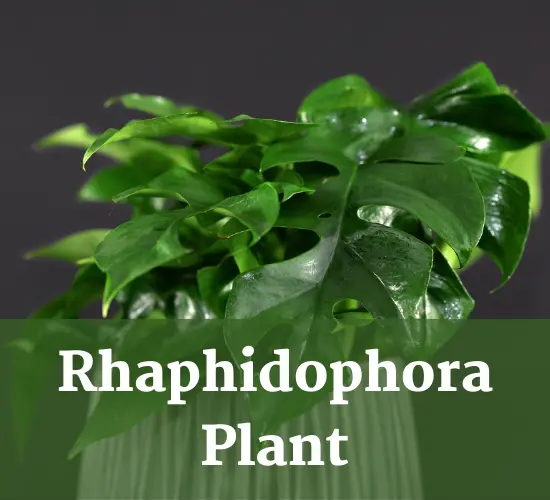Table of Contents
Rhaphidophora Care Guide
The Rhaphidophora, often mistaken for the popular Monstera, is a unique and eye-catching plant that can bring life into any home. With its distinctive charm and bold, perforate leaves, it is sure to spark conversations and become a conversation piece in your space.
This comprehensive care guide will provide you with all the necessary information to unleash the bold beauty of Rhaphidophora in your home.
In this article, we will explore the plant’s description and characteristics, including its appearance and growth habits. We will also delve into the ideal lighting conditions and watering requirements for Rhaphidophora, ensuring that you can provide the optimal environment for its growth. Additionally, we will provide tips for growth and maintenance, address common issues that may arise, and offer expert advice on how to care for this unique plant.
By following this care guide, you will not only enhance the aesthetic appeal of your space but also create an environment that promotes the well-being and growth of the Rhaphidophora.
So, whether you are a seasoned plant enthusiast or just starting your indoor gardening journey, get ready to unleash the bold beauty of Rhaphidophora and enjoy the freedom it brings to your home.
Key Takeaways

- Rhaphidophora is often mistaken for Monstera but is a unique plant in its own right.
- Rhaphidophora prefers bright, indirect light and can survive in medium-light conditions.
- Water the Rhaphidophora when the top 50–75% of the soil is dry, and discard any accumulated water in the saucer.
- Rhaphidophora is toxic to pets and humans, so caution should be taken when handling or ingesting the plant.
Plant Description and Characteristics
Rhaphidophora, with its bold, perforate leaves, stands as a distinct plant that adds a unique touch to any home and is often mistaken for Monstera due to its striking appearance.
This climbing plant belongs to the Araceae family and is closely related to Monstera, Philodendron, and Pothos. Rhaphidophora is native to Thailand and Malaysia, where it thrives in warm, humid, and bright spots. Its leaves are large, glossy, and deeply incised, creating a beautiful and tropical aesthetic. The perforations in its leaves give it an interesting and intricate look, making it a captivating addition to any indoor space.
Rhaphidophora propagation can be done through stem cuttings or air layering. Stem cuttings should be taken from the nodes, ensuring that each cutting has at least one leaf and a root node. These cuttings can be rooted in water or directly in a well-draining soil mixture.
Air layering involves making a small incision in the stem and wrapping it with moist sphagnum moss, which encourages the development of roots. Once roots have formed, the stem can be cut below the moss and planted in a new pot.
Regular pruning is essential for maintaining the health and appearance of Rhaphidophora. Pruning techniques include cutting back long and leggy stems to promote branching and fuller growth. Dead or yellowed leaves should be removed regularly to encourage new growth and prevent the spread of diseases. When pruning, it is important to use clean, sharp shears to avoid damaging the plant.
Additionally, washing the leaves frequently helps to prevent dust from clogging the pores and affecting the plant’s ability to photosynthesize efficiently.
By practicing proper propagation and pruning techniques, Rhaphidophora owners can ensure the longevity and vitality of their plants.
Light and Water Requirements

When it comes to the light and water requirements of growing Rhaphidophora indoors, it is important to provide bright, indirect light for optimal growth. This plant thrives in well-lit areas but should be protected from direct sunlight, as it can burn the foliage. While Rhaphidophora can tolerate medium-light conditions, it may result in slower growth and smaller leaves.
To ensure the health of your plant, it is recommended to water it when the top 50–75% of the soil is dry. This will prevent overwatering, which can lead to root rot, and underwatering, which can cause the leaves to wilt. When watering, it is best to thoroughly soak the soil until the water flows through the drainage hole, and then discard any excess water in the saucer to prevent waterlogging.
To help you enjoy growing Rhaphidophora indoors, here are four key points to keep in mind:
- Provide bright, indirect light. Rhaphidophora prefers a well-lit environment but should be shielded from direct sunlight. Placing it near a window with sheer curtains or in a spot with filtered light is ideal.
- Water when the soil is dry: Check the moisture level of the soil by inserting your finger into the top few inches. Water the plant when the soil feels dry to the touch, but avoid overwatering or letting the plant sit in standing water.
- Maintain moderate humidity: Basic household humidity is sufficient for Rhaphidophora, but higher humidity levels can encourage larger leaf growth. You can increase humidity by misting the plant occasionally or placing a tray of water nearby.
- Avoid drafts and temperature extremes. Rhaphidophora thrives in temperatures between 70-80 degrees Fahrenheit (21-27 degrees Celsius). Keep the plant away from drafts, especially during the winter, as cold drafts can cause stress and damage to the leaves.
By following these guidelines, you can provide the optimal light and water conditions for your Rhaphidophora, allowing it to thrive and unleash its bold beauty in your indoor space.
Tips for Growth and Maintenance
To ensure the optimal growth and maintenance of your Rhaphidophora plant, it is important to follow these key tips. First, pruning techniques are essential for promoting healthy growth and maintaining the plant’s appearance. Regularly remove dead or yellowing leaves by cutting them close to the stem with clean, sharp shears. This encourages new growth and prevents the plant from wasting energy on decaying foliage. Additionally, washing the leaves frequently helps prevent dust from clogging the pores and inhibiting photosynthesis. Simply wipe the leaves gently with a damp cloth or spray them with water to keep them clean and healthy.
Preventing common issues is also crucial in caring for your Rhaphidophora. One common issue is curling leaves, which can be caused by overwatering or underwatering. Ensure that you are watering the plant appropriately by checking the moisture level of the soil. Another common issue is yellowing leaves, which may be a sign of nutrient deficiencies or improper lighting. Be sure to provide adequate fertilization with a liquid fertilizer for indoor plants once a month during the growing season. Additionally, ensure that the plant is receiving the right amount of light. Too much direct sunlight can burn the foliage, while too little light can result in stunted growth or smaller leaves. By following these pruning techniques and preventing common issues, you can maintain the health and vitality of your Rhaphidophora plant.
People also read
Frequently Asked Questions
Can Rhaphidophora be grown outdoors in colder climates?
Rhaphidophora is not suitable for outdoor growth in colder climates due to its preference for warm and humid conditions. Overwintering in colder regions may result in damage or death to the plant.
What are some common pests or diseases that can affect Rhaphidophora?
Common pests and diseases for Rhaphidophora include spider mites, mealybugs, and scale insects. To prevent infestations, regularly inspect the plant and isolate affected specimens. Treatment options include using insecticidal soap, and neem oil, or wiping the pests off with a damp cloth. Root rot can occur if the plant is overwatered or the soil is poorly drained. To identify root rot, look for yellowing leaves, wilting, and a foul odor. Treatment involves removing affected roots, repotting in fresh, well-draining soil, and adjusting watering habits.
How often should I repot my Rhaphidophora?
The best time to repot a Rhaphidophora is when it becomes root-bound or when the soil is not draining properly. Signs that it needs repotting include roots growing out of the drainage holes and slow growth.
Can I propagate Rhaphidophora from cuttings?
Propagation of Rhaphidophora can be done through stem cuttings. The best time for propagation is during spring or early summer. Ensure the cutting has at least two nodes, and place it in a well-draining medium until roots develop.
Are there any specific pruning techniques I should follow for Rhaphidophora?
To maintain the shape of Rhaphidophora, pruning techniques can be employed. For example, regular removal of dead leaves using clean shears promotes healthy growth. Washing leaves frequently prevents dust accumulation and maintains the plant’s beauty.
2 thoughts on “Unleash The Bold Beauty: Rhaphidophora Care Guide”